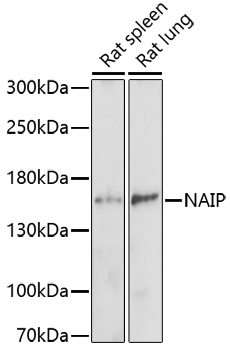-
Product Name
NAIP Polyclonal Antibody
- Documents
-
Description
Polyclonal antibody to NAIP
-
Tested applications
WB
-
Species reactivity
Rat
-
Alternative names
NAIP antibody; BIRC1 antibody; NLRB1 antibody; psiNAIP antibody; NLR family apoptosis inhibitory protein antibody
-
Isotype
Rabbit IgG
-
Preparation
Antigen: A synthetic peptide corresponding to a sequence within amino acids 750-850 of human NAIP (NP_075043.1).
-
Clonality
Polyclonal
-
Formulation
PBS with 0.02% sodium azide, 50% glycerol, pH7.3.
-
Storage instructions
Store at -20℃. Avoid freeze / thaw cycles.
-
Applications
WB 1:500 - 1:2000
-
Validations

Western blot - NAIP Polyclonal Antibody
Western blot analysis of extracts of various cell lines,using NAIP antibody at 1:1000 dilution.Secondary antibody: HRP Goat Anti-Rabbit IgG (H+L) at 1:10000 dilution.Lysates/proteins: 25ug per lane.Blocking buffer: 3% nonfat dry milk in TBST.Detection: ECL Basic Kit .Exposure time: 10s.
-
Background
Anti-apoptotic protein which acts by inhibiting the activities of CASP3, CASP7 and CASP9. Can inhibit the autocleavage of pro-CASP9 and cleavage of pro-CASP3 by CASP9. Capable of inhibiting CASP9 autoproteolysis at 'Asp-315' and decreasing the rate of auto proteolysis at 'Asp-330'. Acts as a mediator of neuronal survival in pathological conditions. Prevents motor-neuron apoptosis induced by a variety of signals. Possible role in the prevention of spinal muscular atrophy that seems to be caused by inappropriate persistence of motor-neuron apoptosis: mutated or deleted forms of NAIP have been found in individuals with severe spinal muscular atrophy.; Acts as a sensor component of the NLRC4 inflammasome that specifically recognizes and binds needle protein CprI from pathogenic bacteria C.violaceum. Association of pathogenic bacteria proteins drives in turn drive assembly and activation of the NLRC4 inflammasome, promoting caspase-1 activation, cytokine production and macrophage pyroptosis. The NLRC4 inflammasome is activated as part of the innate immune response to a range of intracellular bacteria such as C.violaceum and L.pneumophila.
Related Products / Services
Please note: All products are "FOR RESEARCH USE ONLY AND ARE NOT INTENDED FOR DIAGNOSTIC OR THERAPEUTIC USE"
